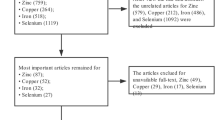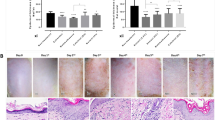Abstract
The effects of zinc chloride (ZnCl2), disodium zinc ethylenediamine tetraacetate (Zn-EDTA), and zinc gluconate (Zn-GLU) on the antioxidant enzyme activities and levels of interleukins (ILs) in psoriasis-induced mice were studied. One hundred twenty female mice were randomly divided into six groups with 20 mice in each group: the control, positive control (PC), methotrexate (MTX), ZnCl2, Zn-EDTA, and Zn-GLU groups. All animals except the control group were given diethylstilbestrol for three consecutive days. After successfully inducing psoriasis, the control and PC groups were given normal saline (i.g.) daily while the remaining groups were given MTX, ZnCl2, Zn-EDTA, and Zn-GLU, respectively. The results revealed that the zinc supplementation could significantly (p < 0.05) inhibit mitosis in the mouse vaginal epithelium as methotrexate did and the inhibiting efficacy had nothing to do with the zinc forms. After ZnCl2, Zn-EDTA, and Zn-GLU supplementation, the levels of liver superoxide dismutase (SOD), glutathione peroxidase (GSH-Px), and catalase (CAT) activities increased and the concentration of malondialdehyde (MDA) decreased significantly (p < 0.05) compared to the PC group. The levels of SOD, CAT activity, and MDA level between each zinc supplementation group and MTX group were insignificant (p > 0.05). The zinc treatments also caused a significant (p < 0.05) decrease in the raised IL-2 level of animal serum. The results obtained in the present work indicate the potential for zinc as a complementary pharmaceutical intervention for the treatment of topical psoriasis.

Similar content being viewed by others
References
DiSepio D, Chandraratna RA, Nagpal S (1999) Novel approaches for the treatment of psoriasis. Drug Discov Today 4(5):222–231
Pietrzak AT, Zalewska A, Chodorowska G et al (2008) Cytokines and anticytokines in psoriasis. Clin Chim Acta 394(1):7–21
Bonifati C, Trento E, Cordiali-Fei P et al (1997) Increased interleukin-7 concentrations in lesional skin and in the sera of patients with plaque-type psoriasis. Clin Immunol Immunopathol 83(1):41–44
Armstrong AW, Voyles SV, Armstrong EJ, Fuller EN, Rutledge JC (2011) Angiogenesis and oxidative stress: common mechanisms linking psoriasis with atherosclerosis. J Dermatol Sci 63:1–9
Kural BV, Orem A, Cimsit G, Yandi YE, Calapoglu M (2003) Evaluation of the atherogenic tendency of lipids and lipoprotein content and their relationships with oxidant–antioxidant system in patients with psoriasis. Clin Chim Acta 328:71–82
Zhou Q, Mrowietz U, Rostami-Yazdi M (2009) Oxidative stress in the pathogenesis of psoriasis. Free Radical Biol Med 47:891–905
Mariani E, Mangialasche F, Feliziani FT et al (2008) Effects of zinc supplementation on antioxidant enzyme activities in healthy old subjects. Exp Gerontol 43:445–451
Balaban RS, Nemoto S, Finkel T (2005) Mitochondria, oxidants, and aging. Cell 120:483–495
Naziroglu M (2012) Molecular role of catalase on oxidative stress-induced Ca2+ signaling and TRP cation channel activation in nervous system. J Recept Signal Transduct Res 32(3):134–141
Nazıroğlu M (2007) New molecular mechanisms on the activation of TRPM2 channels by oxidative stress and ADP-ribose. Neurochem Res 32(11):1990–2001
Jemai H, Messaoudi I, Chaouch A, Kerkeni A (2007) Protective effect of zinc supplementation on blood antioxidant defense system in rats exposed to cadmium. J Trace Elem Med Biol 21:269–273
Santon A, Irato P, Medici V, D’Inca R, Albergoni LV, Sturniolo GC (2003) Effect and possible role of Zn treatment in LEC rats, an animal model of Wilson’s disease. Biochim Biophys Acta 1637(1):91–97
Nordberg M, Nordberg GF (2000) Toxicological aspects of metallothionein. Cell Mol Biol 46:452–463
Tandon SK, Singh S, Prasad S, Mathur N (2001) Hepatic and renal metallothionein induction by an oral equimolar dose of zinc, cadmium or mercury in mice. Food Chem Toxicol 39:571–577
Faure P, Bouvard S, Roucard C, Favier A, Halimi S (2005) Zinc protects HeLa-tat cells against free radical cytotoxicity induced by glucose. J Trace Elem Med Biol 18:269–276
Bonder RH, Van Scott EJ (1971) Use of mouse vaginal and rectal epithelium to screen antimitotic effects of systemically administered drugs. Cancer Res 31(6):851–853
Misra HP, Fridovich I (1972) The role of superoxide anion in the autoxidation of epinephrine and a simple assay for superoxide dismutase. J Biol Chem 247(10):3170–3175
Sykes J, McCormack F, O’Brien T (1978) A preliminary study of the superoxide dismutase content of some human tumors. Cancer Res 38(9):2759–2762
Flohe L, Gunzler WA (1984) Assays of glutathione peroxidase. Methods Enzymol 105:114–121
Havir EA, McHale NA (1987) Biochemical and developmental characterization of multiple forms of catalase in tobacco leaves. Plant Physiol 84(2):450–455
Draper HH, Hadley M (1990) Malondialdehyde determination as index of lipid peroxidation. Methods Enzymol 186:421–431
Y-j W, K-A L, Tong S-Y (1997) A linear regression method for the study of the Coomassie brilliant blue protein assay. Talanta 44(5):923–930
Kaur M, Bahia MS, Silakari O (2012) Inhibitors of interleukin-2 inducible T-cell kinase as potential therapeutic candidates for the treatment of various inflammatory disease conditions. Eur J Pharm Sci 47(3):574–588
Kemmett D, Symons JA, Colver GB, Duff GW (1990) Serum-soluble interleukin 2 receptor in psoriasis. Failure to reflect clinical improvement. Acta Derm-Venereol 70(3):264–266
Asadullah K, Sterry W, Stephanek K et al (1998) IL-10 is a key cytokine in psoriasis. Proof of principle by IL-10 therapy: a new therapeutic approach. J Clin Incest 101(4):783–794
Nockowski P, Baran W (2005) Novel approach to psoriasis. Terapia 3:20–24
Mussi A, Bonifati C, Carducci M et al (1994) IL-10 levels are decreased in psoriatic lesional skin as compared to the psoriatic lesional-free and normal skin suction blister fluids. J Biol Regul Homeost Agent 8(4):117–120
Kingo K, Ratsep R, Koksb S, Karelson M, Silm H, Vasar E (2005) Influence of genetic polymorphisms on interleukin-10 mRNA expression and psoriasis susceptibility. J Dermatol Sci 37(2):111–113
Kaur S, Zilmer K, Leping V, Zilmer M (2012) Comparative study of systemic inflammatory responses in psoriasis vulgaris and mild to moderate allergic contact dermatitis. Dermatology 225(1):54–61
Michalak-Stoma A, Pietrzak A, Szepietowski JC, Zalewska-Janowska A, Paszkowski T, Chodorowska G (2011) Cytokine network in psoriasis revisited. Eur Cytokine Netw 22(4):160–168
Nazıroğlu M, Yıldız K, Tamtürk B, Erturan I, Flores-Arce M (2012) Selenium and psoriasis. Biol Trace Elem Res 150(1–3):3–9
Kökçam I, Naziroğlu M (1999) Antioxidants and lipid peroxidation status in the blood of patients with psoriasis. Clin Chim Acta 289(1–2):23–31
Mansouri A, Hamidatou Alghem L, Beladel B, Mokhtari OEK, Bendaas A, Benamar MEA (2013) Hair-zinc levels determination in Algerian psoriatics using instrumental neutron activation analysis (INAA). Appl Radiat Isot 72:177–181
Arora PN, Dhillon KS, Rajan SR, Sayal SK, Das AL (2002) Serum zinc levels in cutaneous disorders. MJAFl 58(4):304–306
Kharaeva Z, Gostova E, De Luca C, Raskovic D, Korkina L (2009) Clinical and biochemical effects of coenzyme Q10, vitamin E, and selenium supplementation to psoriasis patients. Nutrition 25(3):295–302
Afridi HI, Kazi TG, Kazi N et al (2011) Evaluation of cadmium, chromium, nickel, and zinc in biological samples of psoriasis patients living in Pakistani cement factory area. Biol Trace Elem Res 142(3):284–301
Author information
Authors and Affiliations
Corresponding author
Rights and permissions
About this article
Cite this article
Yin, L.L., Zhang, Y., Guo, D.M. et al. Effects of Zinc on Interleukins and Antioxidant Enzyme Values in Psoriasis-Induced Mice. Biol Trace Elem Res 155, 411–415 (2013). https://doi.org/10.1007/s12011-013-9799-0
Received:
Accepted:
Published:
Issue Date:
DOI: https://doi.org/10.1007/s12011-013-9799-0




